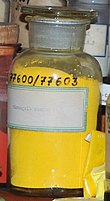Lead(II) chromate is an inorganic compound with the chemical formula PbCrO4. It is a yellow orange solid that is very poorly soluble in water. It occurs also as the mineral crocoite. It is used as a pigment.

| |

| |
| Names | |
|---|---|
| Other names
see text | |
| Identifiers | |
| ChEBI | |
| ECHA InfoCard | 100.028.951 |
| EC Number |
|
PubChem CID |
|
| RTECS number |
|
| UNII | |
| UN number | 3288 |
CompTox Dashboard (EPA) |
|
| Properties | |
| PbCrO4 | |
| Molar mass | 323.192 g/mol |
| Appearance | orange-yellow powder |
| Density | 6.12 g/cm3, solid |
| 0.00001720 g/100 mL (20 ºC)[1] | |
| Solubility | soluble in diluted nitric acid insoluble in acetic acid, ammonia |
| −18.0·10−6cm3/mol | |
Refractive index (nD) |
2.31 |
| Structure | |
| monoclinic | |
| Hazards | |
| Occupational safety and health (OHS/OSH): | |
Main hazards |
Carcinogen and highly toxic |
| GHS labelling: | |
  
| |
| Danger | |
| H350, H360, H373, H410 | |
| P201, P273, P308+P313, P501 | |
| NFPA 704 (fire diamond) | |
| Lethal dose or concentration (LD, LC): | |
LD50 (median dose) |
>12 g/kg (mouse, oral) |
| Safety data sheet (SDS) | ICSC 0003 Sigma-Aldrich |
Except where otherwise noted, data are given for materials in their standard state (at 25 °C [77 °F], 100 kPa). | |
Two polymorphs of lead chromate are known, orthorhombic and the more stable monoclinic form. Monoclinic lead chromate is used in paints under the name chrome yellow, and many other names.[2] Lead chromate adopts the monazite structure, meaning that the connectivity of the atoms is very similar to other compounds of the type MM'O4. Pb(II) has a distorted coordination sphere being surrounded by eight oxides with Pb-O distances ranging from 2.53 to 2.80 Å. The chromate anion is tetrahedral, as usual.[3] Unstable polymorphs of lead chromate are the greenish yellow orthorhombic form and a red-orange tetragonal form.[2]
Approximately 37,000 tons were produced in 1996. The main applications are as a pigment in paints, under the name chrome yellow.[6]
Lead(II) chromate can be produced by treating sodium chromate with lead salts such as lead(II) nitrate or by combining lead(II) oxide with chromic acid.
Related lead sulfochromate pigments are produced by the replacement of some chromate by sulfate, resulting in a mixed lead-chromate-sulfate compositions Pb(CrO4)1−x(SO4)x. This replacement is possible because sulfate and chromate are isostructural. Since sulfate is colorless, sulfochromates with high values of x are less intensely colored than lead chromate.[6] In some cases, chromate is replaced by molybdate.[2]
Heating in hydroxide solution produces chrome red, a red or orange powder made by PbO and CrO3. Also, in hydroxide solution lead chromate slowly dissolves forming plumbite complex.
Despite containing both lead and hexavalent chromium, lead chromate is not acutely lethal because of its very low solubility. The LD50 for rats is only 5,000 mg/kg. Lead chromate must be treated with great care in its manufacture, the main concerns being dust of the chromate precursor. Lead chromate is highly regulated in advanced countries. As one of the greatest threats comes from inhalation of particles, so much effort has been devoted to production of low-dust forms of the pigment.[2]
In the 1800s, the product was used to impart a bright yellow color to some types of candy.[7] It is used (illegally) to enhance the color of certain spices, particularly turmeric,[8][9] particularly in Bangladesh.[10][11]
Unlike other lead-based paint pigments, lead chromate is still widely used, especially in road marking paint.[12]
In 2023 and 2024, consumption of adulterated cinnamon[13] led to at least 136 cases of lead toxicity in children in the United States as reported by the US Centers for Disease Control and Prevention.[14] The affected products were recalled.[13] The US Food and Drug Administration determined that the ratio of lead to chromium in the cinammon indicated that lead chromate had been added to the cinnamon.[13]